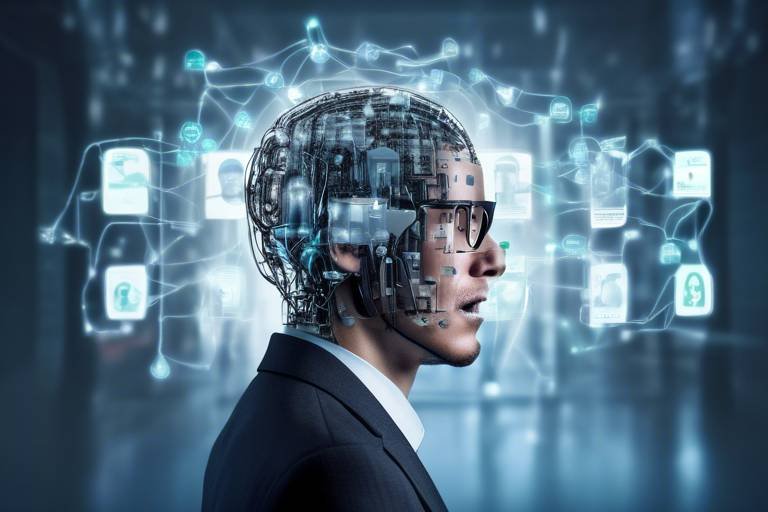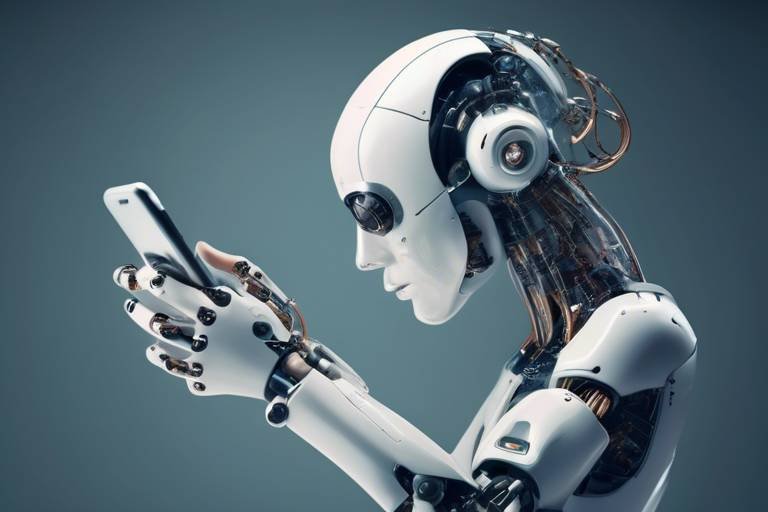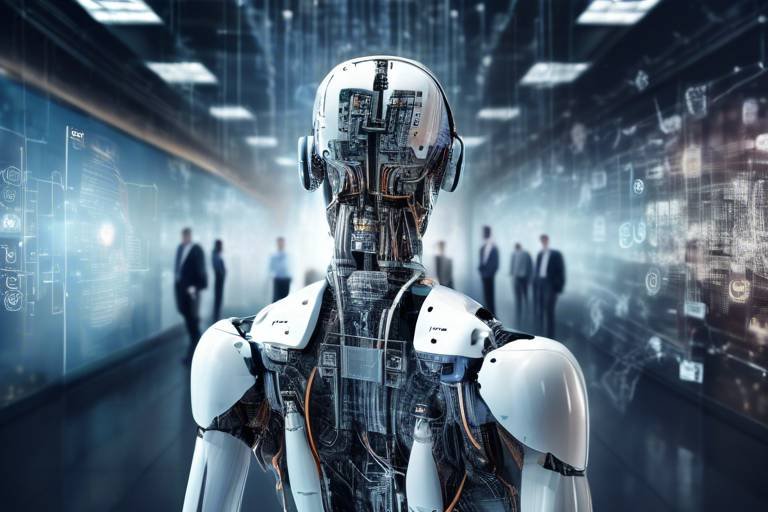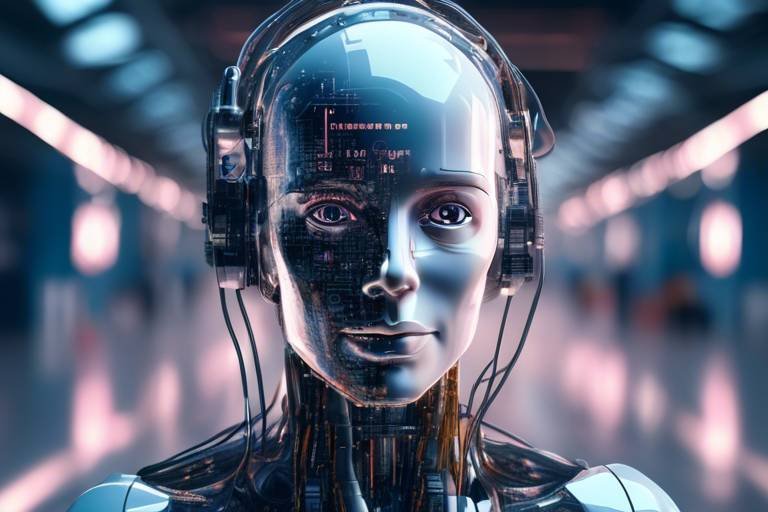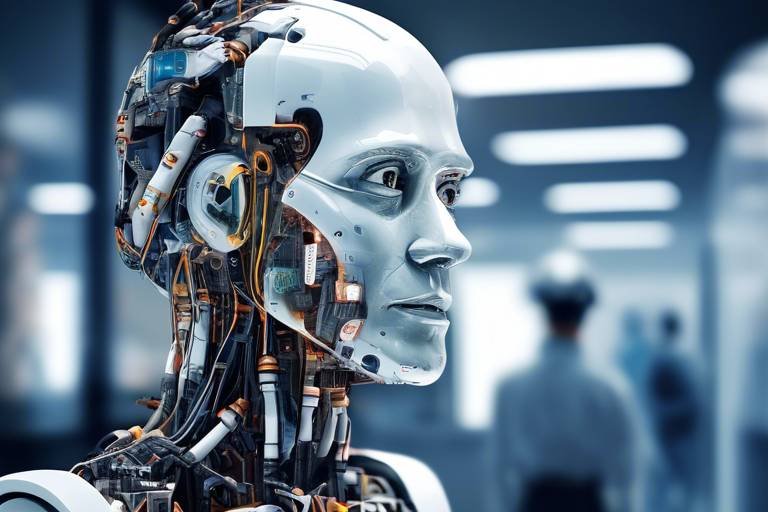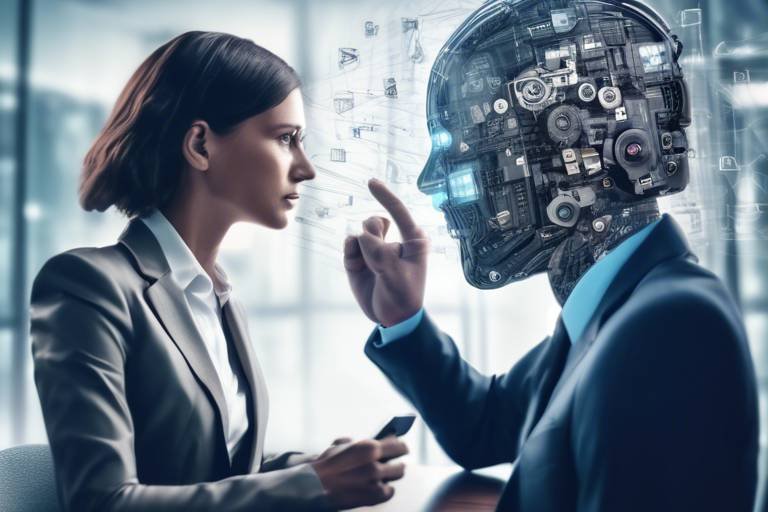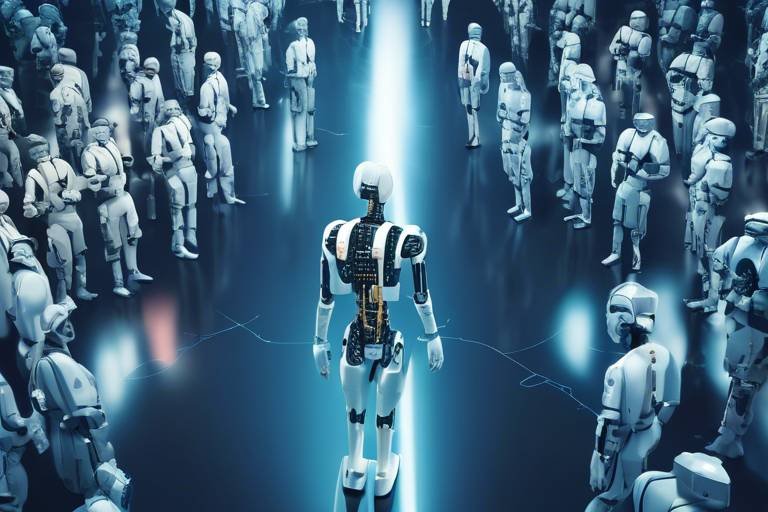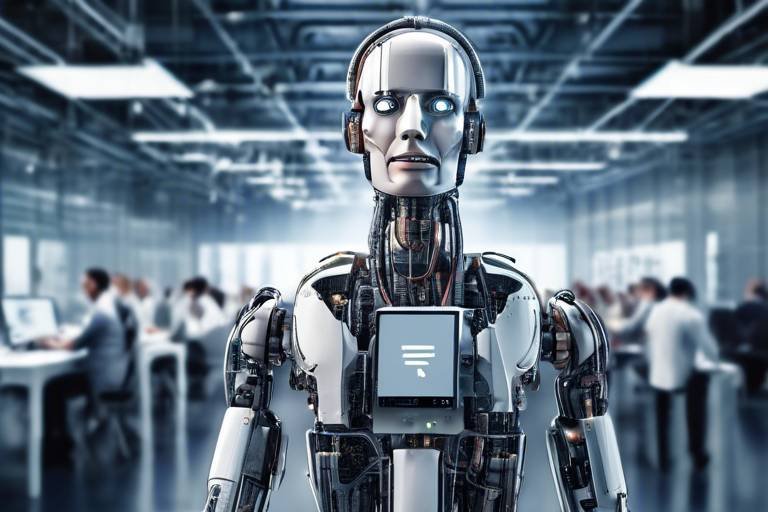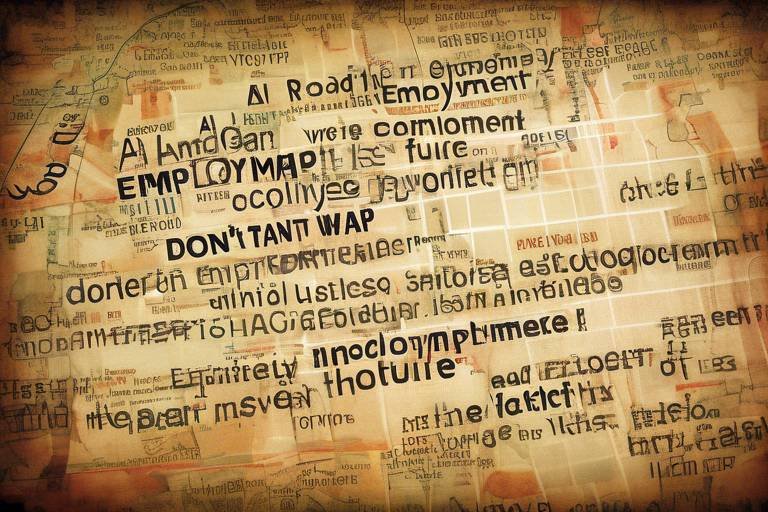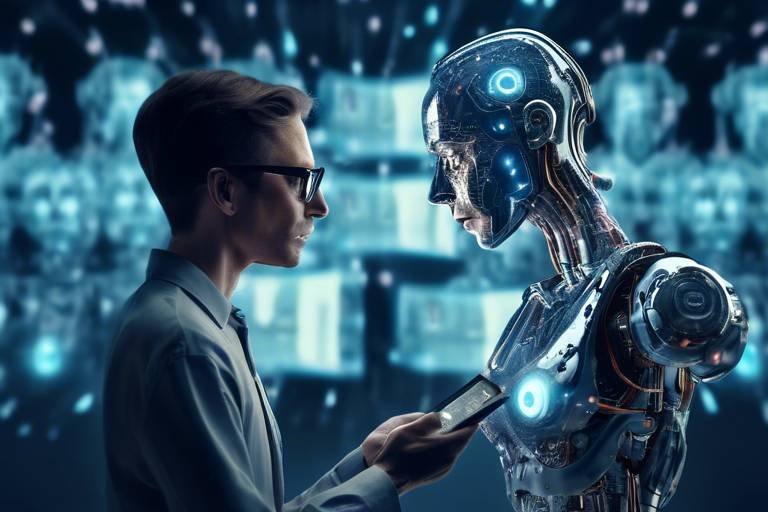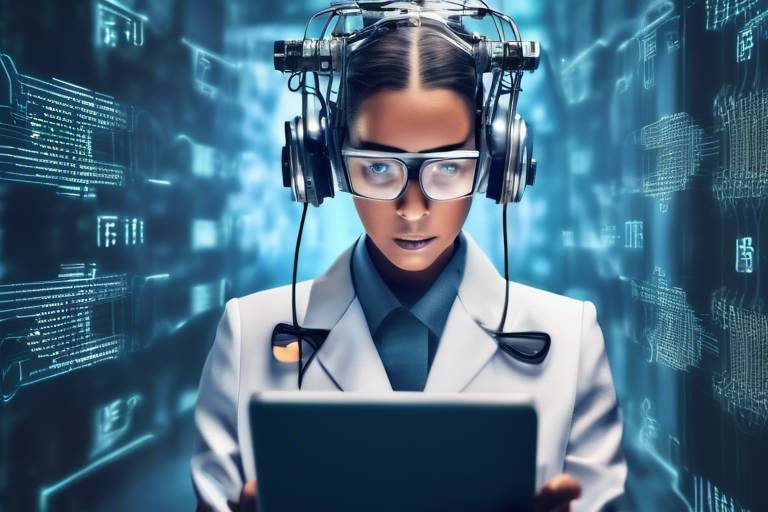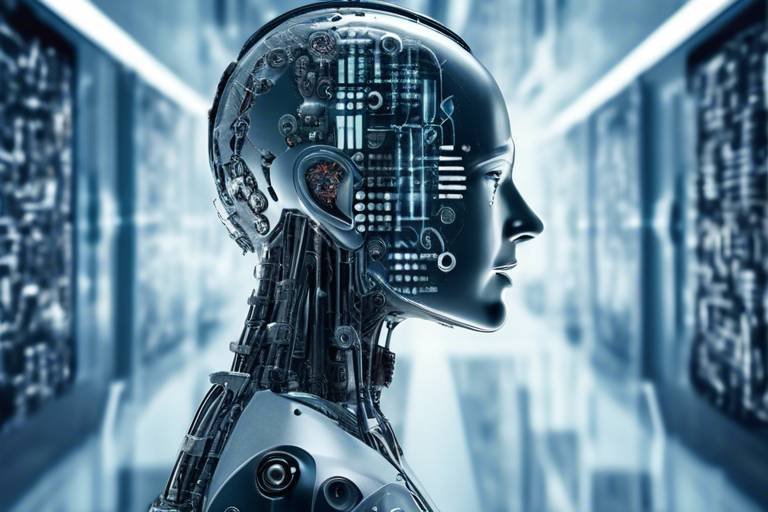Safe Adoption of AI: Future Guidelines for the Workforce
In today's rapidly evolving technological landscape, the integration of Artificial Intelligence (AI) into the workforce is not just a trend; it's becoming a necessity. As organizations strive to enhance their productivity and efficiency, the adoption of AI tools presents both exciting opportunities and significant challenges. The journey towards a successful AI integration involves careful planning and consideration of various factors, including ethical implications, employee training, and the impact on job roles. This article aims to explore essential guidelines for the safe adoption of AI in the workplace, ensuring that both businesses and employees can thrive in this new era.
AI technologies are reshaping industries by automating tasks, analyzing vast amounts of data, and providing insights that were previously unimaginable. From customer service chatbots to advanced data analytics in finance, AI applications are diverse and transformative. However, while AI can significantly boost productivity, it also carries potential risks that cannot be overlooked. For instance, the reliance on AI might lead to over-dependence, where human skills atrophy over time. Organizations must strike a balance between leveraging AI for efficiency and maintaining the essential human element in their operations.
As we embrace AI in the workplace, ethical considerations become paramount. The implementation of AI systems must be guided by principles of fairness, accountability, and transparency. These principles help ensure that AI technologies do not perpetuate bias or discrimination against any group. For example, if an AI hiring tool is trained on biased data, it may favor certain demographics over others, leading to unfair hiring practices. Therefore, organizations must be vigilant in deploying AI responsibly, ensuring that their systems operate within ethical boundaries.
Bias in AI algorithms is a critical issue that deserves attention. When AI systems are trained on biased datasets, the outcomes can be skewed, resulting in unfair treatment of individuals. For instance, facial recognition technologies have faced scrutiny for misidentifying people of color due to unrepresentative training data. To combat this problem, it is essential to utilize diverse datasets that reflect the population accurately. By doing so, organizations can create AI systems that are more inclusive and fair.
To effectively reduce bias in AI algorithms, organizations can implement several strategies:
- Conduct regular audits of AI systems to identify and rectify biases.
- Assemble diverse development teams that bring various perspectives to the table.
- Adopt inclusive data practices that ensure representation across different demographics.
These strategies not only enhance the fairness of AI systems but also build trust among employees and stakeholders.
As the use of AI continues to grow, so does the need for regulatory frameworks that govern its ethical use. Various governments and organizations are working to establish guidelines and standards that promote responsible AI deployment. These frameworks aim to provide a structured approach to AI ethics, ensuring that organizations prioritize fairness and accountability in their AI initiatives. By adhering to these regulations, businesses can foster a culture of ethical AI use that benefits everyone involved.
As AI systems become more prevalent, the importance of employee training cannot be overstated. Organizations must invest in reskilling and upskilling initiatives to prepare their workforce for the changing landscape. Training programs should focus on enhancing digital literacy and equipping employees with the skills needed to work alongside AI technologies. By empowering employees through education, organizations can ease the transition into an AI-enhanced workplace, fostering a culture of continuous learning and adaptability.
The adoption of AI is transforming job roles across various industries. While some positions may be at risk of displacement, new opportunities are also emerging. For instance, roles that require human creativity, emotional intelligence, and complex problem-solving will remain in demand. Organizations must recognize the dual nature of AI's impact: while it may automate certain tasks, it also creates a need for new skill sets and job roles that leverage AI technology.
As AI continues to advance, several new job roles are emerging, including:
- AI trainers who teach AI systems to understand human language and behavior.
- Data ethicists who ensure that AI systems operate within ethical boundaries.
- AI maintenance specialists who oversee the performance and reliability of AI tools.
These roles highlight the need for workers to adapt to the evolving demands of the job market, embracing lifelong learning as a crucial component of their careers.
To facilitate a smooth transition into AI-enhanced roles, organizations must prioritize reskilling programs. These initiatives should focus on equipping employees with the necessary skills to thrive in an AI-driven environment. By offering training in data analysis, machine learning, and AI ethics, businesses can ensure that their workforce is prepared for the future. Ultimately, investing in employee development not only benefits individuals but also contributes to the overall success of the organization.
Q: What are the main benefits of AI in the workplace?
A: AI can enhance productivity, streamline operations, and provide valuable insights through data analysis, ultimately leading to improved decision-making.
Q: How can organizations ensure ethical AI use?
A: Organizations can ensure ethical AI use by implementing diverse datasets, conducting regular audits, and adhering to established regulatory frameworks.
Q: What skills will be important in an AI-driven job market?
A: Skills such as data analysis, critical thinking, and emotional intelligence will be crucial in navigating the AI-driven job market.

Understanding AI in the Workplace
Artificial Intelligence (AI) has rapidly become a game-changer in the modern workplace, revolutionizing the way businesses operate across various industries. From automating mundane tasks to providing deep insights through data analysis, AI technologies are enhancing productivity and efficiency like never before. Imagine a world where your computer can learn from your work patterns, predict your needs, and even help you make better decisions—this is not science fiction; this is the reality of AI in the workplace today.
The applications of AI are vast and varied, touching sectors such as healthcare, finance, manufacturing, and customer service. For instance, in healthcare, AI algorithms can analyze medical images to assist doctors in diagnosing diseases more accurately and swiftly. In finance, AI-powered tools can detect fraudulent transactions in real-time, safeguarding businesses and consumers alike. Moreover, AI chatbots are transforming customer service by providing instant responses to inquiries, improving customer satisfaction while reducing operational costs.
However, as we embrace these technological advancements, it's crucial to acknowledge the potential risks that accompany them. AI systems, while powerful, are not infallible. They rely heavily on the data fed into them, and if that data is flawed or biased, the outcomes can be equally problematic. This raises important questions: How do we ensure that AI is used ethically? What measures should be taken to protect employees and consumers from unintended consequences? To address these concerns, organizations must adopt a careful and responsible approach to AI integration.
One of the key benefits of AI is its ability to enhance productivity. By automating repetitive tasks, employees can focus on more strategic and creative aspects of their jobs. This not only boosts morale but also fosters innovation. For instance, a marketing team using AI tools for data analysis can spend more time crafting compelling campaigns rather than sifting through spreadsheets. However, this shift also necessitates that employees adapt to new technologies, which brings us to the importance of comprehensive training programs.
In summary, understanding AI in the workplace is about recognizing both its potential and its pitfalls. Organizations must strike a balance between leveraging AI for efficiency while ensuring that ethical considerations are at the forefront of their strategies. As we delve deeper into the ethical implications and the necessary training for employees, we can pave the way for a future where AI and human intelligence coexist harmoniously, driving growth and innovation.

Ethical Considerations in AI Adoption
As we dive into the world of Artificial Intelligence (AI), it's crucial to pause and reflect on the ethical considerations that come with its adoption in the workplace. The integration of AI isn't just about the technology itself; it's also about how we use it responsibly. In a landscape where machines can make decisions, the principles of fairness, accountability, and transparency become paramount. These ethical pillars are essential to ensure that AI serves as a tool for progress rather than a source of division.
One of the most pressing concerns is the potential for bias in AI systems. AI algorithms learn from data, and if that data is skewed or unrepresentative, the outcomes can be discriminatory. For instance, consider an AI hiring tool that predominantly learns from a dataset reflecting a particular demographic. If this dataset lacks diversity, the AI might favor candidates from that demographic, leading to unfair hiring practices. This is where the responsibility of organizations comes into play. They must ensure that the data used for training AI is inclusive and representative of all groups.
Bias in AI algorithms can manifest in various ways, impacting decisions related to hiring, promotions, and even customer service. It's like trying to navigate a maze with a blindfold; without proper visibility into the data and its sources, organizations risk making decisions that perpetuate inequality. To combat this, companies must prioritize diverse datasets when training their AI models. This means actively seeking out data that reflects a variety of perspectives and experiences, which can help create a more balanced AI system.
So, how can organizations tackle the issue of bias in AI? Here are a few effective strategies:
- Regular Audits: Conducting audits of AI systems can help identify biases in algorithms and rectify them before they cause harm.
- Diverse Development Teams: Having a team with varied backgrounds and experiences can lead to more robust AI solutions that consider multiple viewpoints.
- Inclusive Data Practices: Actively sourcing data from a diverse range of demographics ensures that AI systems are trained on comprehensive datasets.
Moreover, the conversation around AI ethics extends to the need for regulatory frameworks. Governments and industry leaders must collaborate to establish guidelines that promote ethical AI use. These frameworks can help set standards that protect individuals from potential biases and ensure that AI technologies are deployed responsibly. By implementing regulations, we not only safeguard employees but also foster a culture of trust in AI systems.
Currently, various regulatory bodies are working on establishing guidelines for AI ethics. These frameworks aim to address the ethical implications of AI by introducing principles that organizations must adhere to. For instance, the European Union has proposed regulations that emphasize the importance of transparency and accountability in AI systems. As these frameworks evolve, they will play a critical role in shaping how AI is integrated into the workplace.
In conclusion, the ethical considerations surrounding AI adoption are not just an afterthought; they are a fundamental component of responsible AI integration. By focusing on fairness, accountability, and transparency, organizations can harness the power of AI while ensuring that it benefits everyone. The road to ethical AI is paved with challenges, but with the right strategies and frameworks in place, we can create a future where technology and humanity coexist harmoniously.
Q: What are the main ethical concerns regarding AI in the workplace?
A: The main ethical concerns include bias in AI algorithms, accountability for AI decisions, and the need for transparency in how AI systems operate.
Q: How can organizations ensure their AI systems are fair?
A: Organizations can ensure fairness by using diverse datasets, conducting regular audits of their AI systems, and fostering diverse development teams.
Q: What role do regulatory frameworks play in AI ethics?
A: Regulatory frameworks provide guidelines and standards for ethical AI use, helping to prevent bias and promote accountability in AI systems.

Bias in AI Algorithms
In the rapidly evolving landscape of artificial intelligence, the issue of has emerged as a crucial challenge that organizations must address. When we talk about bias in AI, we refer to the systematic favoritism or discrimination that can occur within AI systems, often stemming from the data used to train these models. Imagine teaching a child using only a limited set of examples; the child may form skewed perceptions based on those examples. Similarly, AI systems learn from the data they are fed, and if that data is biased, the outcomes can be unfair or discriminatory.
The impact of biased algorithms can be far-reaching, affecting various aspects of society, including hiring processes, loan approvals, and even law enforcement. For instance, if an AI system used in recruitment is trained on historical hiring data that reflects past biases, it might inadvertently favor certain demographics over others. This not only raises ethical concerns but also poses a significant risk to the credibility and fairness of AI applications in the workplace.
To better understand how bias manifests in AI, let’s consider some common sources of bias:
- Data Bias: This occurs when the training data is not representative of the broader population. For example, if an AI model is trained predominantly on data from one demographic group, it may struggle to perform well for others.
- Algorithmic Bias: Even with unbiased data, the algorithms themselves can introduce bias through their design and decision-making processes.
- Human Bias: Bias can also creep in through the decisions made by the developers and data scientists who build these AI systems, often unconsciously reflecting their own biases.
Addressing bias in AI algorithms is not merely a technical issue; it’s a societal imperative. Organizations must prioritize the use of diverse datasets when training their AI models. This means ensuring that the data encompasses a wide range of perspectives and backgrounds. By doing so, companies can enhance the fairness and accuracy of their AI systems, ultimately leading to better decision-making processes.
It's also essential to implement regular audits of AI systems to identify and rectify any biases that may arise over time. This proactive approach not only helps in maintaining the integrity of AI applications but also builds trust among users and stakeholders. After all, in a world increasingly driven by technology, the ethical deployment of AI should be a shared responsibility among developers, organizations, and society at large.
In conclusion, the challenge of bias in AI algorithms is significant, but it is not insurmountable. Through a combination of diverse data practices, comprehensive audits, and a commitment to ethical standards, organizations can pave the way for a more equitable future in AI. The journey towards bias-free AI is ongoing, and it requires vigilance, dedication, and a willingness to adapt.
- What is bias in AI algorithms? Bias in AI algorithms refers to the unfair treatment or favoritism that can occur when AI systems are trained on biased data or designed with inherent biases.
- How can organizations mitigate bias in AI? Organizations can mitigate bias by using diverse datasets, conducting regular audits of their AI systems, and involving diverse teams in the development process.
- Why is addressing bias in AI important? Addressing bias is crucial to ensure fairness, accountability, and transparency in AI applications, which can significantly impact individuals and society.

Strategies to Mitigate Bias
In the rapidly evolving landscape of artificial intelligence, addressing bias is not just a technical challenge; it’s a moral imperative. Bias in AI algorithms can lead to significant consequences, affecting everything from hiring practices to customer service interactions. Therefore, implementing effective strategies to mitigate bias is crucial for organizations aiming to deploy AI responsibly and ethically.
One of the most effective strategies is to conduct regular audits of AI systems. These audits should assess the algorithms for any signs of bias and ensure that they are functioning as intended. Think of this process like a routine health check-up for your AI: it helps identify potential issues before they become serious problems. Regular audits can involve testing the AI with diverse datasets to see how it performs across different demographics. This practice not only helps in identifying biases but also promotes accountability.
Another strategy is to assemble diverse development teams. When teams are composed of individuals from various backgrounds, they bring different perspectives that can help identify potential biases in AI systems. This diversity should extend beyond just ethnicity and gender; it should include varying educational backgrounds, experiences, and even geographic locations. The more varied the team, the better equipped they will be to foresee and address issues that could lead to biased outcomes.
Furthermore, organizations should focus on inclusive data practices. The data used to train AI models is often where bias creeps in. If the training data is skewed or unrepresentative of the population, the AI will likely reflect those biases. To combat this, companies should prioritize collecting data from a broad range of sources and demographics. This means actively seeking out underrepresented groups and ensuring their experiences and perspectives are included in the datasets. By doing so, the AI can be trained to make more equitable decisions.
Lastly, fostering a culture of awareness and education around AI bias is essential. Organizations should provide training sessions for employees to understand how bias can manifest in AI systems and the importance of mitigating it. This can include workshops, seminars, or even online courses that educate staff about the implications of biased algorithms and the significance of ethical AI practices. When everyone in the organization is informed and engaged, it creates a collective responsibility to uphold fairness and transparency.
In summary, mitigating bias in AI is a multifaceted challenge that requires a combination of regular audits, diverse teams, inclusive data practices, and ongoing education. By implementing these strategies, organizations can not only improve the fairness of their AI systems but also foster a more ethical and inclusive workplace.
- What is AI bias? AI bias occurs when an algorithm produces unfair outcomes due to prejudiced data or assumptions embedded in the system.
- How can organizations identify bias in their AI systems? Through regular audits and testing with diverse datasets, organizations can identify and address bias in their AI algorithms.
- Why is diversity in development teams important? Diverse teams bring a variety of perspectives that can help identify potential biases and create more equitable AI systems.
- What role does data play in AI bias? The quality and representation of training data significantly influence the fairness of AI systems; biased data leads to biased outcomes.
- How can organizations foster a culture of awareness around AI bias? By providing training and resources that educate employees about AI bias and its implications, organizations can promote a culture of responsibility.

Regulatory Frameworks for AI Ethics
The rapid advancement of artificial intelligence (AI) technologies has prompted a pressing need for robust regulatory frameworks that govern their ethical use in the workplace. As organizations increasingly rely on AI to enhance productivity and streamline operations, the potential for misuse and unintended consequences grows. Therefore, establishing clear guidelines is not just beneficial; it is essential for ensuring that AI serves humanity positively and ethically.
One of the primary challenges in developing these frameworks is the dynamic nature of AI technology. Unlike traditional technologies, AI evolves rapidly, making it difficult for existing regulations to keep pace. This situation creates a paradox where businesses are eager to adopt AI innovations while simultaneously facing uncertainty about compliance with ethical standards. Thus, a proactive approach to regulation is necessary, one that allows for flexibility and adaptability in the face of technological change.
Several countries and organizations are already taking steps to formulate comprehensive AI regulations. For instance, the European Union has proposed the AI Act, which aims to create a legal framework that categorizes AI systems based on their risk levels. This act emphasizes the need for transparency, accountability, and human oversight, ensuring that AI technologies do not operate in a black box. Similarly, the United States is exploring various initiatives at both federal and state levels to address AI ethics, focusing on principles such as fairness and non-discrimination.
Moreover, industry standards are also emerging as a critical component of AI regulation. Organizations like the Institute of Electrical and Electronics Engineers (IEEE) and the International Organization for Standardization (ISO) are working to establish ethical guidelines and best practices for AI development and deployment. These standards aim to provide businesses with a framework that encourages responsible AI use while also fostering innovation.
In addition to formal regulations and industry standards, it is crucial for organizations to develop their own internal policies that align with ethical AI practices. This includes conducting regular audits of AI systems to identify potential biases and ensuring that diverse teams are involved in the development process. By fostering a culture of accountability and transparency, organizations can not only comply with external regulations but also build trust with their employees and customers.
In conclusion, the establishment of regulatory frameworks for AI ethics is an ongoing process that requires collaboration among governments, industries, and organizations. As we move forward, it is imperative to strike a balance between innovation and ethical responsibility, ensuring that AI technologies enhance our lives without compromising our values.
- What are regulatory frameworks for AI ethics? Regulatory frameworks for AI ethics are guidelines and standards established to ensure that AI technologies are developed and used responsibly, addressing issues such as fairness, accountability, and transparency.
- Why are these frameworks important? These frameworks are crucial to prevent misuse of AI technologies, protect individuals from discrimination, and foster public trust in AI systems.
- How can organizations ensure compliance with AI regulations? Organizations can ensure compliance by staying informed about relevant regulations, conducting regular audits of their AI systems, and developing internal policies that promote ethical AI practices.
- What role do industry standards play in AI regulation? Industry standards provide best practices and guidelines for AI development and deployment, helping organizations navigate the complexities of ethical AI use.

Employee Training and Adaptation
As we stand on the brink of a technological revolution, the integration of Artificial Intelligence (AI) into the workplace is not just a trend; it's becoming a necessity. However, with great power comes great responsibility, and that includes the need for effective employee training. Organizations must recognize that their workforce is not just a collection of workers, but a dynamic group of individuals who need to be equipped with the right skills to thrive in an AI-enhanced environment. But how can companies ensure that their employees are prepared to adapt to these changes?
Firstly, it’s essential to understand that training must be tailored to the specific needs of each organization and its employees. This means conducting thorough assessments to identify the current skill levels and gaps within the workforce. By leveraging tools such as surveys and performance reviews, companies can create a customized training program that addresses the unique challenges and opportunities presented by AI technologies.
Moreover, training should not be a one-time event; it should be an ongoing process. Just like how a plant needs continuous care to grow, employees need regular updates and training sessions to keep pace with the rapid advancements in AI. This can be achieved through a combination of formal training programs, workshops, and hands-on experiences. For instance, companies can partner with educational institutions to offer courses that focus on AI literacy, data analysis, and machine learning.
In addition to formal training, organizations should foster a culture of continuous learning. Encouraging employees to pursue online courses, attend conferences, or engage in peer-to-peer learning can significantly enhance their adaptability. By creating an environment where learning is valued, companies can empower their workforce to embrace AI technologies rather than fear them.
Furthermore, it’s crucial to address the emotional aspect of adaptation. Change can be daunting, and employees may feel overwhelmed by the prospect of AI taking over their roles. To alleviate these concerns, organizations should communicate openly about the benefits of AI. For example, AI can take over mundane tasks, allowing employees to focus on more strategic and creative aspects of their jobs. By framing AI as a tool for augmentation rather than replacement, companies can foster a positive mindset towards these innovations.
Lastly, organizations should consider implementing mentorship programs where experienced employees can guide their peers through the transition. This not only helps in knowledge transfer but also builds a sense of community and support within the workplace. By pairing tech-savvy employees with those who may be less familiar with AI, companies can create a collaborative environment that encourages adaptation and innovation.
In conclusion, the successful integration of AI into the workforce hinges on comprehensive training and a supportive culture. By investing in employee education and fostering an environment of continuous learning, organizations can ensure that their workforce is not only prepared for the future but is also excited to embrace the changes that AI brings. After all, the future of work is not about machines replacing humans; it’s about humans and machines working together to achieve greater heights.
- What is the importance of employee training in AI integration?
Employee training is crucial as it ensures that workers are equipped with the necessary skills to effectively use AI technologies, enhancing productivity and job satisfaction. - How can organizations create a culture of continuous learning?
Organizations can promote continuous learning by offering regular training sessions, encouraging online courses, and facilitating peer-to-peer learning opportunities. - What role does communication play in adapting to AI?
Open communication helps alleviate fears associated with AI, framing it as a tool for enhancement rather than replacement, which fosters a positive attitude towards change. - Are mentorship programs effective in AI training?
Yes, mentorship programs can be very effective as they facilitate knowledge transfer and provide emotional support during transitions.

Impact on Job Roles and Responsibilities
The integration of Artificial Intelligence (AI) into the workplace is not just a technological shift; it's a seismic change that reverberates through every level of an organization. As AI systems take on more tasks traditionally performed by humans, the landscape of job roles and responsibilities is evolving dramatically. Imagine a world where mundane tasks are automated, allowing employees to focus on more creative and strategic endeavors. Sounds exciting, right? However, this transition also brings with it a cloud of uncertainty regarding job displacement and the need for new skill sets.
First and foremost, it's essential to understand that AI is not here to replace humans entirely; rather, it aims to enhance human capabilities. For instance, in sectors like healthcare, AI can assist doctors by analyzing vast amounts of data to identify patterns and suggest diagnoses. This doesn't eliminate the need for doctors; instead, it allows them to make more informed decisions and spend more time interacting with patients. Thus, the role of healthcare professionals is transforming, shifting from routine analysis to more personalized patient care.
Yet, with this transformation comes the reality of potential job displacement. Jobs that involve repetitive tasks are at a higher risk of being automated. In manufacturing, for example, robots can assemble products faster and with greater precision than human workers. This shift prompts the question: what happens to those workers? The answer lies in reskilling and upskilling. Organizations must invest in training programs to help employees transition into new roles that AI technology creates. Think of it as a bridge; without it, workers may find themselves stranded on one side of a rapidly changing job market.
To illustrate this point, let’s look at a table that outlines the transformation of job roles across various industries:
| Industry | Traditional Role | Transformed Role |
|---|---|---|
| Manufacturing | Assembly Line Worker | Automation Technician |
| Healthcare | Data Entry Clerk | Data Analyst |
| Finance | Accountant | Financial Analyst |
| Retail | Cashier | Customer Experience Specialist |
This table highlights how AI is not just replacing jobs but also transforming them into roles that require higher levels of skill and expertise. As we can see, the traditional roles are evolving into positions that focus more on analysis, strategy, and customer experience. This shift emphasizes the need for a workforce that is adaptable and ready to embrace change.
Moreover, the emergence of new job opportunities is a silver lining in this AI-driven transformation. As organizations adopt advanced technologies, they will require professionals who can manage and maintain these systems. Roles such as AI ethicists, data scientists, and AI trainers are becoming increasingly vital. These positions not only reflect the changing nature of work but also highlight the importance of ethical considerations in AI deployment.
In conclusion, the impact of AI on job roles and responsibilities is profound and multifaceted. While there are challenges to navigate, such as job displacement and the need for new skills, there are also exciting opportunities for growth and innovation. Organizations that prioritize employee training and embrace the changes brought about by AI will not only survive but thrive in this new era of work. The future is bright for those willing to adapt, learn, and grow alongside these technological advancements.
- Will AI completely replace human jobs? No, AI is designed to enhance human capabilities, not replace them entirely.
- What types of jobs are most at risk of automation? Jobs that involve repetitive tasks, such as assembly line work and data entry, are more susceptible to automation.
- How can employees prepare for the changes brought by AI? Employees can prepare by engaging in reskilling and upskilling programs offered by their organizations.
- What new job opportunities are emerging due to AI? New roles such as AI ethicists, data scientists, and automation technicians are becoming increasingly important.

Emerging Job Opportunities
As we navigate the rapidly evolving landscape of artificial intelligence, it's essential to recognize that while some jobs may become obsolete, new opportunities are blossoming in unexpected areas. The integration of AI into various sectors is not just a technological shift; it's a transformative wave that is reshaping the job market in profound ways. Imagine a world where AI doesn't just replace jobs but creates entirely new roles that we haven't even thought of yet. This is the reality we're stepping into!
One of the most exciting aspects of AI integration is the emergence of roles that blend human creativity with technological prowess. For instance, positions such as AI Ethicist are becoming increasingly vital. These professionals are tasked with ensuring that AI systems are designed and implemented ethically, addressing concerns like bias and fairness. It’s a role that requires a deep understanding of both technology and societal values, making it a unique career path that didn't exist a decade ago.
Another area witnessing growth is in data analysis and management. As AI systems generate vast amounts of data, organizations need skilled professionals who can interpret this information to drive decision-making. Roles such as Data Curator or AI Trainer are becoming more common, focusing on the quality and relevance of data used to train AI models. These positions not only require technical expertise but also a keen eye for detail and an understanding of the business context.
Moreover, the rise of AI is fueling demand for AI Maintenance Specialists. These technicians are responsible for the ongoing maintenance and troubleshooting of AI systems, ensuring they operate effectively and efficiently. This role is crucial as companies increasingly rely on AI for critical operations. The need for human oversight in AI systems is a clear indication that technology and human skills must work hand in hand.
In addition to these roles, we are also seeing a surge in demand for Creative AI Specialists. These individuals leverage AI tools to enhance creative processes in fields such as marketing, design, and entertainment. They’re not just using AI; they’re collaborating with it to push the boundaries of what’s possible in creative expression. Imagine a marketing campaign designed with the help of AI that predicts consumer behavior—this is the future, and it requires a new set of skills.
To summarize, the job market is not merely shrinking due to AI; it’s expanding into new territories. Here’s a quick overview of some of the emerging job opportunities:
| Job Title | Description |
|---|---|
| AI Ethicist | Ensures ethical considerations are integrated into AI systems. |
| Data Curator | Manages and maintains the quality of data used for AI training. |
| AI Maintenance Specialist | Handles the upkeep and troubleshooting of AI systems. |
| Creative AI Specialist | Uses AI tools to enhance creativity in various industries. |
As we look ahead, it's clear that the workforce must adapt to these changes. Reskilling and upskilling will be essential for those looking to thrive in this new environment. Embracing lifelong learning and being open to new experiences will be key. The future isn't just about surviving in a world with AI; it's about leveraging these technologies to unlock our potential and create a more innovative workforce.
Q1: Will AI take away all jobs?
A1: While AI may automate certain tasks, it will also create new job opportunities that require human skills and creativity. The job market is evolving, not disappearing.
Q2: What skills will be in demand in the future?
A2: Skills in data analysis, AI ethics, creative thinking, and technology maintenance will be increasingly valuable as AI becomes more integrated into various industries.
Q3: How can I prepare for a career in an AI-driven workforce?
A3: Focus on continuous learning, seek out reskilling and upskilling opportunities, and stay updated on AI trends and technologies relevant to your field.

Reskilling for the Future
As we stand on the brink of a technological revolution driven by artificial intelligence (AI), the need for reskilling has never been more critical. The rapid integration of AI into various sectors is reshaping job roles, and with this transformation comes the undeniable reality that many employees will need to adapt their skills to remain relevant in the workforce. Imagine the workplace as a constantly evolving landscape, where those who can navigate the changes will thrive, while others may find themselves left behind. So, how do we prepare for this future?
First and foremost, organizations must recognize that investing in their workforce is not just a good practice; it’s a necessity. Reskilling programs should be tailored to address the specific needs of both the company and its employees. This means conducting thorough assessments to identify skill gaps and understanding the future demands of the industry. For instance, a company in the manufacturing sector may find that employees need training in AI-driven machinery, while those in customer service may require skills in managing AI chatbots and analytics.
Moreover, effective reskilling isn’t a one-time event; it’s an ongoing journey. Companies should foster a culture of continuous learning, encouraging employees to pursue upskilling opportunities regularly. This could involve partnerships with educational institutions, online courses, or even in-house training programs. By creating an environment where learning is valued, organizations can empower their employees to take charge of their career paths.
Another vital aspect of reskilling is the focus on soft skills. While technical skills are essential, the human element cannot be overlooked. Skills such as critical thinking, emotional intelligence, and adaptability are increasingly valuable in a world where AI handles routine tasks. Employees who can complement AI capabilities with their unique human skills will be in high demand. Imagine a scenario where an AI system analyzes data, but it takes a human to interpret the findings and make strategic decisions based on them.
To illustrate the importance of reskilling, consider the following table that outlines the key areas of focus for reskilling initiatives:
| Skill Area | Description | Examples of Training |
|---|---|---|
| Technical Skills | Skills related to specific technologies and tools used in the workplace. | Programming, AI tools, Data Analysis |
| Soft Skills | Interpersonal skills that enhance communication and collaboration. | Emotional Intelligence, Leadership, Problem Solving |
| Adaptability | The ability to adjust to new conditions and challenges. | Change Management, Resilience Training |
In addition to structured training programs, organizations should also encourage employees to take ownership of their learning. This can be facilitated through mentorship programs, where experienced employees guide others in navigating the complexities of AI integration. By fostering a sense of community and collaboration, companies can create a supportive environment that promotes growth and innovation.
Ultimately, the path to a successful future in the AI-driven workforce lies in a commitment to reskilling. As the saying goes, “The only constant in life is change.” By embracing this change and equipping employees with the necessary skills, organizations can not only enhance productivity but also cultivate a workforce that is ready to tackle the challenges of tomorrow. So, are you ready to invest in your future?
- What is reskilling? Reskilling refers to the process of teaching employees new skills to help them adapt to changing job requirements, especially in the context of AI and technology integration.
- Why is reskilling important? Reskilling is crucial to ensure that employees remain relevant in their roles, can leverage new technologies effectively, and contribute to the overall success of the organization.
- How can organizations implement effective reskilling programs? Organizations can implement effective reskilling programs by assessing skill gaps, providing tailored training, fostering a culture of continuous learning, and encouraging mentorship opportunities.
- What skills should employees focus on for the future? Employees should focus on both technical skills related to AI and technology, as well as soft skills like critical thinking, emotional intelligence, and adaptability.
Frequently Asked Questions
- What is AI, and how is it used in the workplace?
AI, or Artificial Intelligence, refers to computer systems that can perform tasks typically requiring human intelligence, such as problem-solving, learning, and decision-making. In the workplace, AI is used for various applications, including automating repetitive tasks, analyzing data for insights, enhancing customer service through chatbots, and improving operational efficiency.
- What are the ethical considerations when adopting AI?
When adopting AI, organizations must consider several ethical factors, such as fairness, accountability, and transparency. It's crucial to ensure that AI systems do not perpetuate bias or discrimination. This involves using diverse datasets, conducting regular audits, and being transparent about how AI decisions are made.
- How can bias in AI algorithms be mitigated?
To mitigate bias in AI algorithms, organizations can implement various strategies, including regular audits of AI systems, employing diverse development teams, and utilizing inclusive data practices. These steps help ensure that AI models are trained on representative data, reducing the likelihood of biased outcomes.
- What role does employee training play in AI integration?
Employee training is vital for successful AI integration. Organizations should focus on reskilling and upskilling initiatives to prepare their workforce for new technologies. By providing training, employees can adapt to changes, understand how to work alongside AI, and leverage it to enhance their productivity.
- Will AI lead to job displacement?
While AI may displace certain job roles, it also creates new opportunities. Many jobs will evolve, requiring different skills. The key is for employees to be proactive in reskilling and adapting to these changes, ensuring they remain valuable in the workforce.
- What new job opportunities are emerging due to AI?
As AI technology advances, new job roles are emerging, such as AI specialists, data scientists, and AI ethics compliance officers. These roles focus on developing, managing, and ensuring the ethical use of AI systems in various industries, highlighting the need for a skilled workforce that can navigate this evolving landscape.
- How can organizations support reskilling for the future?
Organizations can support reskilling by offering training programs tailored to the skills needed for future roles. This can include workshops, online courses, and partnerships with educational institutions to provide employees with the necessary knowledge and skills to thrive in an AI-driven environment.


